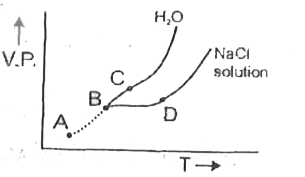During depression of freezing point in a solution, the following are in equilibrium:
Liquid solvent,solid solvent
Liquid solvent, solid solute
Liquid solute, solid solute
Liquid solute, solid solvent
To solve the question regarding the equilibrium during the depression of freezing point in a solution, we will follow these steps:
1. Understanding Freezing Point Depression:
- Freezing point depression occurs when a solute is added to a solvent, resulting in a lower freezing point than that of the pure solvent.
2. Identifying Phases at Freezing Point:
- At the freezing point, the system is in equilibrium between the solid and liquid phases of the solvent. This means that both the solid form of the solvent and the liquid form of the solvent coexist.
3. Equilibrium Condition:
- For a substance to be at equilibrium at its freezing point, the vapor pressures of the solid and liquid phases must be equal. This is crucial because if they were not equal, the system would not be in equilibrium.
4. Conclusion:
- Therefore, during the depression of freezing point in a solution, the phases that are in equilibrium are the liquid solvent and the solid solvent.
Final Answer:
The equilibrium during the depression of freezing point in a solution involves the liquid solvent and solid solvent.
---
- Freezing point depression occurs when a solute is added to a solvent, resulting in a lower freezing point than that of the pure solvent.
- At the freezing point, the system is in equilibrium between the solid and liquid phases of the solvent. This means that both the solid form of the solvent and the liquid form of the solvent coexist.
- For a substance to be at equilibrium at its freezing point, the vapor pressures of the solid and liquid phases must be equal. This is crucial because if they were not equal, the system would not be in equilibrium.
- Therefore, during the depression of freezing point in a solution, the phases that are in equilibrium are the liquid solvent and the solid solvent.
The equilibrium during the depression of freezing point in a solution involves the liquid solvent and solid solvent.
Topper's Solved these Questions
- BOOK - RESONANCE ENGLISHCHAPTER - SOLUTIONSEXERCISE - Advabced Level Problems (PART-2)35videos
SOLUTIONS
- BOOK - RESONANCE ENGLISHCHAPTER - SOLUTIONSEXERCISE - EXERCISE-3(PART-3)30videos
SOLUTIONS
- BOOK - RESONANCE ENGLISHCHAPTER - SOLUTION AND COLLIGATIVE PROPERTIESEXERCISE - PHYSICAL CHEMITRY (SOLUTION & COLLIGATIVE PROPERTIES)52videos
SOLUTION AND COLLIGATIVE PROPERTIES
- BOOK - RESONANCE ENGLISHCHAPTER - STEREOISOMERISMEXERCISE - EXERCISE (PART III : PRACTICE TEST-2 (IIT-JEE (ADVANCED PATTERN))23videos
STEREOISOMERISM
Similar Questions
Knowledge Check
- Question 1 - Select One
Depression of freezing point of which of the following solutions does represent the cryoscopic constant of water ?
A6% by mass of urea in aqueous solutionB100 g of aqueous solution containing 18 g of glucoseC59 g of aqueous solution containing 9 of glucoseD1 M KCI solution in water
Depression in freezing point of solution of electrolytes are generally
View SolutionThe depression of freezing points of 0.05 molal aqueous solution of the following compounds are measured.
1.NaCl2.K_(2)SO_(4)3.C_(6)H_(12)O_(6)4.Al_(2)(SO_(4))_(3)
Which one of the above compounds will exhibit the maximum depression of freezing point ?View Solution
Freezing point of solution is marked asView SolutionFor the depression in freezing point experiment, the correct statement(s) is/are:
View SolutionIn the depression of freezing point experiment, it is found that the:
View SolutionMX2 dissociates into M2+ and Xө ion in an aqueous solution, with a degree of dissociation (α) of 0.5. The ratio of the observed depression of freezing point of the aqueous solution to the value of the depression of freezing point in absence of ionic dissociation is
View SolutionIn depression of freezing point method camphor is a suitable solvent as its
View Solution

